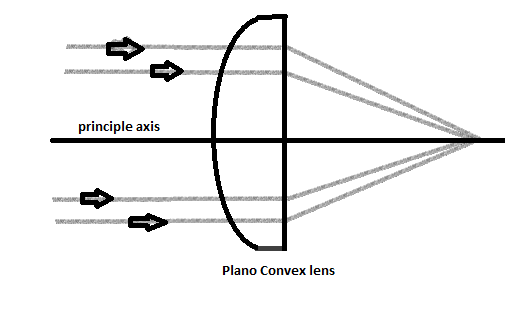
Answer
471.6k+ views
Hint: Here, we will proceed by directly applying the formula for the focal length of the Plano convex lens. We are given the radius of the curvature of the convex surface and the refractive index of the material of the lens with which we can easily find out the focal length of the Plano-Convex lens.
Formula used: $\dfrac{1}{f} = (\dfrac{{{\mu _2}}}{{{\mu _1}}} - 1)(\dfrac{1}{{R_1}} - \dfrac{1}{{R_2}})$
Complete Step-by-Step solution:

The radius of the curvature of the convex surface of a Plano-convex lens is given as 20 cm.
The refractive index of the material of the lens is 1.5
The focal length of the Plano convex lens can be calculated by the formula
$\dfrac{1}{f} = (\dfrac{{{\mu _2}}}{{{\mu _1}}} - 1)(\dfrac{1}{{R_1}} - \dfrac{1}{{R_2}})$
Here, f is the focal length of the Plano-convex lens.
${\mu _2}$ is the refractive index of the material of the lens.
${\mu _1}$ is the refractive index of the surrounding.
$R_1$ is the Radius of the curvature of the side on which the incident ray falls.
$R_2$ is the Radius of the curvature of the other side of the lens.
Here in this question, there is no other material given so we will take air as surrounding. The refractive index of the air is 1.
Also, the radius of the curvature of the plane mirror is infinity. So, the radius of the curvature of the plane side of the lens is infinity.
By assigning all the values in the formula, we will get the focal length of the Plano-convex lens
$
\therefore \dfrac{1}{f} = (\dfrac{{1.5}}{1} - 1)(\dfrac{1}{{20}} - \dfrac{1}{\infty }) \\
\Rightarrow \dfrac{1}{f} = (\dfrac{1}{2})(\dfrac{1}{{20}} - 0) \\
\Rightarrow \dfrac{1}{f} = \dfrac{1}{{40}} \\
\Rightarrow f = 40{\text{ cm}} \\
$
$\therefore {\text{ Option D is the correct answer}}$
Note- In differential geometry, the radius of curvature, R is the reciprocal of the curvature. For a curve, it equals the radius of the circular arc which best approximates the curve at that point. For surfaces, the radius of curvature is the radius of a circle that best fits a normal section.
Formula used: $\dfrac{1}{f} = (\dfrac{{{\mu _2}}}{{{\mu _1}}} - 1)(\dfrac{1}{{R_1}} - \dfrac{1}{{R_2}})$
Complete Step-by-Step solution:

The radius of the curvature of the convex surface of a Plano-convex lens is given as 20 cm.
The refractive index of the material of the lens is 1.5
The focal length of the Plano convex lens can be calculated by the formula
$\dfrac{1}{f} = (\dfrac{{{\mu _2}}}{{{\mu _1}}} - 1)(\dfrac{1}{{R_1}} - \dfrac{1}{{R_2}})$
Here, f is the focal length of the Plano-convex lens.
${\mu _2}$ is the refractive index of the material of the lens.
${\mu _1}$ is the refractive index of the surrounding.
$R_1$ is the Radius of the curvature of the side on which the incident ray falls.
$R_2$ is the Radius of the curvature of the other side of the lens.
Here in this question, there is no other material given so we will take air as surrounding. The refractive index of the air is 1.
Also, the radius of the curvature of the plane mirror is infinity. So, the radius of the curvature of the plane side of the lens is infinity.
By assigning all the values in the formula, we will get the focal length of the Plano-convex lens
$
\therefore \dfrac{1}{f} = (\dfrac{{1.5}}{1} - 1)(\dfrac{1}{{20}} - \dfrac{1}{\infty }) \\
\Rightarrow \dfrac{1}{f} = (\dfrac{1}{2})(\dfrac{1}{{20}} - 0) \\
\Rightarrow \dfrac{1}{f} = \dfrac{1}{{40}} \\
\Rightarrow f = 40{\text{ cm}} \\
$
$\therefore {\text{ Option D is the correct answer}}$
Note- In differential geometry, the radius of curvature, R is the reciprocal of the curvature. For a curve, it equals the radius of the circular arc which best approximates the curve at that point. For surfaces, the radius of curvature is the radius of a circle that best fits a normal section.
Recently Updated Pages
Identify the feminine gender noun from the given sentence class 10 english CBSE

Your club organized a blood donation camp in your city class 10 english CBSE

Choose the correct meaning of the idiomphrase from class 10 english CBSE

Identify the neuter gender noun from the given sentence class 10 english CBSE

Choose the word which best expresses the meaning of class 10 english CBSE

Choose the word which is closest to the opposite in class 10 english CBSE

Trending doubts
How do you graph the function fx 4x class 9 maths CBSE

Fill the blanks with the suitable prepositions 1 The class 9 english CBSE

Which are the Top 10 Largest Countries of the World?

A rainbow has circular shape because A The earth is class 11 physics CBSE

Change the following sentences into negative and interrogative class 10 english CBSE

The Equation xxx + 2 is Satisfied when x is Equal to Class 10 Maths

Give 10 examples for herbs , shrubs , climbers , creepers

Difference between Prokaryotic cell and Eukaryotic class 11 biology CBSE

One Metric ton is equal to kg A 10000 B 1000 C 100 class 11 physics CBSE




